
The Agaricales are an order of fungi in the division Basidiomycota. As originally conceived, the order contained all the agarics, but subsequent research has shown that not all agarics are closely related and some belong in other orders, such as the Russulales and Boletales. Conversely, DNA research has also shown that many non-agarics, including some of the clavarioid fungi and gasteroid fungi belong within the Agaricales. The order has 46 extant families, more than 400 genera, and over 25,000 described species, along with six extinct genera known only from the fossil record. Species in the Agaricales range from the familiar Agaricus bisporus and the deadly Amanita virosa to the coral-like Clavaria zollingeri and bracket-like Fistulina hepatica.
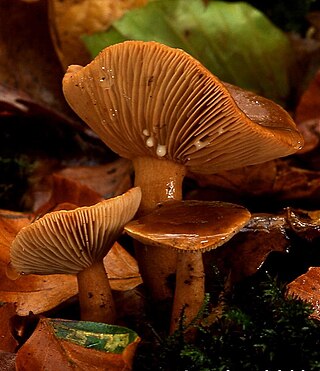
In mycology, a lamella, or gill, is a papery hymenophore rib under the cap of some mushroom species, most often agarics. The gills are used by the mushrooms as a means of spore dispersal, and are important for species identification. The attachment of the gills to the stem is classified based on the shape of the gills when viewed from the side, while color, crowding and the shape of individual gills can also be important features. Additionally, gills can have distinctive microscopic or macroscopic features. For instance, Lactarius species typically seep latex from their gills.

The Marasmiaceae are a family of fungi in the order Agaricales. Basidiocarps are most frequently agarics, but occasionally cyphelloid. According to a 2008 estimate, the family contained 54 genera and 1590 species, but molecular research, based on cladistic analysis of DNA sequences, has led to a more restricted family concept, so that the Marasmiaceae included just 13 genera, and some 1205 species. It was reduced further down in 2020, to 10 genera and about 700 species.

The Clavariaceae are a family of fungi in the order Agaricales. Originally the family contained most of the clavarioid fungi, but in its current sense is more restricted, albeit with a greater diversity of basidiocarp forms. Basidiocarps are variously clavarioid or agaricoid (mushroom-shaped), less commonly corticioid or hydnoid.

The Tricholomataceae are a large family of fungi within the order Agaricales. Originally a classic "wastebasket taxon", the family included any white-, yellow-, or pink-spored genera in the Agaricales not already classified as belonging to e.g. the Amanitaceae, Lepiotaceae, Hygrophoraceae, Pluteaceae, or Entolomataceae.

The Agaricomycetes are a class of fungi in the division Basidiomycota. The taxon is roughly identical to that defined for the Homobasidiomycetes by Hibbett & Thorn, with the inclusion of Auriculariales and Sebacinales. It includes not only mushroom-forming fungi, but also most species placed in the deprecated taxa Gasteromycetes and Homobasidiomycetes. Within the subdivision Agaricomycotina, which already excludes the smut and rust fungi, the Agaricomycetes can be further defined by the exclusion of the classes Tremellomycetes and Dacrymycetes, which are generally considered to be jelly fungi. However, a few former "jelly fungi", such as Auricularia, are classified in the Agaricomycetes. According to a 2008 estimate, Agaricomycetes include 17 orders, 100 families, 1147 genera, and about 21000 species. Modern molecular phylogenetic analyses have been since used to help define several new orders in the Agaricomycetes: Amylocorticiales, Jaapiales, Stereopsidales, and Lepidostromatales.

The Sclerodermataceae are a family of fungi in the order Boletales, containing several genera of unusual fungi that little resemble boletes. Taxa, which include species commonly known as the ‘hard-skinned puffballs’, ‘earthballs’, or 'earthstars', are widespread in both temperate and tropical regions. The best known members include the earthball Scleroderma citrinum, the dye fungus Pisolithus tinctorius and the 'prettymouths' of the genus Calostoma.

Cotylidia is a fungal genus characterized by small to moderately sized, white to palely yet brightly colored, stalked, fan-shaped to funnel-shaped fruit bodies with a smooth to wrinkled hymenium, tissues composed of monomitic hyphae, basidia producing smooth, nonamyloid spores, the absence of clamp connections, and bearing projecting cylindrical, thin-walled, hymenial cystidia. The genus is classified in the Hymenochaetales, however the type species, C. undulata has not yet been sequenced. Phylogenetically-related agaricoid fungi to the two species of Cotylidia thus far sequenced are in the genera Rickenella, Contumyces, Gyroflexus, Loreleia, Cantharellopsis and Blasiphalia, and Muscinupta and the clavarioid genus, Alloclavaria.
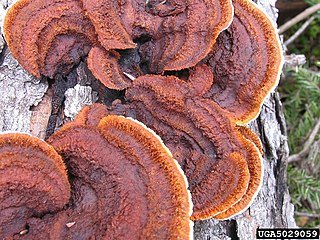
The Gloeophyllales are a phylogenetically defined order of wood-decay fungi that is characterized by the ability to produce a brown rot of wood. It includes a single, identically defined family, the Gloeophyllaceae, in which are included the genera Gloeophyllum, Neolentinus, Heliocybe, and Veluticeps.

The Corticiaceae are a family of fungi in the order Corticiales. The family formerly included almost all the corticioid fungi, whether they were related or not, and as such was highly artificial. In its current sense, however, the name Corticiaceae is restricted to a comparatively small group of corticioid genera within the Corticiales.
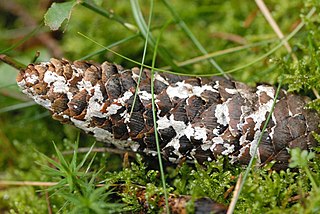
Atheliaceae is a family of corticioid fungi placed under the monotypic order Atheliales. Both the order and the family were described by Walter Jülich in 1981. According to a 2008 estimate, the family contains 20 genera and approximately 100 species. However, many genera formerly considered to belong in the Atheliaceae have since been moved to other families, including Amylocorticiaceae, Albatrellaceae, and Hygrophoraceae. Despite being a relatively small group with inconspicuous forms, Atheliaceae members show great diversity in life strategies and are widespread in distribution. Additionally, being a group strictly composed of corticioid fungi, they may also provide insights on the evolution of fruiting body forms in basidiomycetes.

The Physalacriaceae are a family of fungi in the order Agaricales. Species in the family have a widespread distribution, ranging from the Arctic, (Rhizomarasmius), to the tropics, e.g. Gloiocephala, and from marine sites (Mycaureola) and fresh waters (Gloiocephala) to semiarid forests (Xerula).

The Inocybaceae are a family of fungi in the order Agaricales, the largest order of mushroom-forming fungi. It is one of the larger families within Agaricales. This family exhibits an ectomycorrhizal ecology. Members of this family have a widespread distribution in tropical and temperate areas.

The Mycenaceae are a family of fungi in the order Agaricales. According to the Dictionary of the Fungi, the family contains 10 genera and 705 species. This is one of several families that were separated from the Tricholomataceae as a result of phylogenetic analyses. Taxa in the Mycenaceae are saprobic, have a cosmopolitan distribution, and are found in almost all ecological zones. The family was circumscribed by Caspar van Overeem in 1926.

Trichaptum is a genus of poroid fungi. The genus was circumscribed by American mycologist William Alphonso Murrill in 1904. Formerly classified in the family Polyporaceae, several molecular studies have shown that the genus belongs to the order Hymenochaetales.
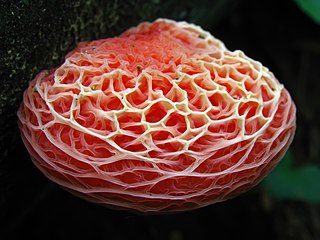
Rhodotus is a genus in the fungus family Physalacriaceae. There are two species in the genus with the best known, Rhodotus palmatus, called the netted rhodotus, the rosy veincap, or the wrinkled peach. This uncommon species has a circumboreal distribution, and has been collected in eastern North America, northern Africa, Europe, and Asia; declining populations in Europe have led to its appearance in over half of the European fungal Red Lists of threatened species. Typically found growing on the stumps and logs of rotting hardwoods, mature specimens may usually be identified by the pinkish color and the distinctive ridged and veined surface of their rubbery caps; variations in the color and quantity of light received during development lead to variations in the size, shape, and cap color of fruit bodies.
The Aphyllophorales is an obsolete order of fungi in the Basidiomycota. The order is entirely artificial, bringing together a miscellany of species now grouped among the clavarioid fungi, corticioid fungi, cyphelloid fungi, hydnoid fungi, and poroid fungi.

Stereopsis is the sole genus of fungi in the family Stereopsidaceae. The genus was formerly placed in the family Meruliaceae in the order Polyporales but was found to belong in its own order along with the genus Clavulicium. Stereopsis was circumscribed by English mycologist Derek Reid in 1965. It contains species that form funnel-shaped basidiocarps as well as the corticioid species Stereopsis globosa which was formerly considered a species of Clavulicium. The species Stereopsis humphreyi and Stereopsis vitellina were found to belong in the Agaricales and Atheliales respectively in a molecular phylogenetics study, and because of this do not belong in Stereopsis, but they have not yet been transferred to their own genera.

Datronia is a genus of poroid crust fungi in the family Polyporaceae. The genus was circumscribed by Marinus Anton Donk in 1966, with Datronia mollis as the type species. Datronia fungi cause a white rot in hardwoods. Datronia contains six species found in northern temperate areas. The most recent addition, Datronia ustulatiligna, was described in 2015 from Himachal Pradesh in India.
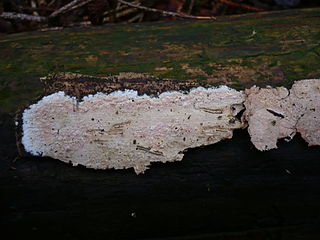
Amylocorticiales is an order of fungi in the class Agaricomycetes. The order was circumscribed in 2010 to contain mostly resupinate (crust-like) forms that have been referred to genera Anomoporia, Amyloathelia, Amylocorticiellum, Amylocorticium, Amyloxenasma, Anomoloma, Athelopsis, Ceraceomyces, Hypochniciellum, Leptosporomyces and Serpulomyces and the anomalous species, Athelia rolfsii, now classified in its own genus, Agroathelia.



















